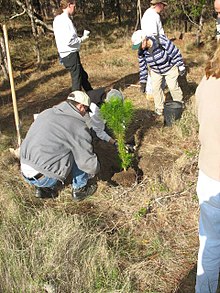User:Asutt/Urban reforestation
| This is the sandbox page where you will draft your initial Wikipedia contribution.
If you're starting a new article, you can develop it here until it's ready to go live. If you're working on improvements to an existing article, copy only one section at a time of the article to this sandbox to work on, and be sure to use an edit summary linking to the article you copied from. Do not copy over the entire article. You can find additional instructions here. Remember to save your work regularly using the "Publish page" button. (It just means 'save'; it will still be in the sandbox.) You can add bold formatting to your additions to differentiate them from existing content. |
Article Draft[edit]
Lead[edit]

In urban areas, improved air quality is important and trees reduce pollutants.[1] This can be done since trees can store carbon dioxide. [1] An increase in shade leads to lessened energy costs as sun is blocked [1] from heating air conditioning using structures.
With these benefits local property values can increase[2], rainwater pollutants can be filtered from the streets, [2] improving water quality[2], as well as creating more space for wildlife[2]/endangered species[1]. This practice of Urban reforestation is a simple way people can tackle all of these issues on a small scaler than large organizations and companies, cost effectively[3] in their communities.
Article body[edit]
In California, there are government funded programs such as the California Department of Forestry and Fire Protection's Urban Forestry Program. They advocate for local sustainability as well as health and happiness for the community long term.[2] The California Department of Forestry and Fire Protection's Urban Forestry Program also uses this idea of elevating a community to assist disadvantaged and/or low-income communities. [4]
Process[edit]
The effectiveness of urban reforestation comes from the fact that is does not require the purchase of a large piece of land to execute. [3]
Criticisms[edit]

Equity of where Urban Reforestation occurs is often questioned. Programs such as California Department of Forestry and Fire Protection's Urban Forestry target these communities but this is not always the case. Inequality in distribution of trees planted during Urban Reforestation leads to inequality of life.[1] Permanence of trees is also an issue as a tree planted is a tree that might have to be removed in the future due to preferences of land owners in urban spaces.[1]
References[edit]
- ^ a b c d e f Perkins, Harold A; Heynen, Nik; Wilson, Joe (2004-08-01). "Inequitable access to urban reforestation: the impact of urban political economy on housing tenure and urban forests". Cities. 21 (4): 291–299. doi:10.1016/j.cities.2004.04.002. ISSN 0264-2751.
- ^ a b c d e "Urban & Community Forestry". www.fire.ca.gov. Retrieved 2022-10-20.
- ^ a b Kroeger, Timm; Escobedo, Francisco J.; Hernandez, José L.; Varela, Sebastián; Delphin, Sonia; Fisher, Jonathan R. B.; Waldron, Janice (2014-10-07). "Reforestation as a novel abatement and compliance measure for ground-level ozone". Proceedings of the National Academy of Sciences. 111 (40). doi:10.1073/pnas.1409785111. ISSN 0027-8424. PMC 4210021. PMID 25201970.
{{cite journal}}: CS1 maint: PMC format (link) - ^ "Urban and Community Forestry Grant Programs". www.fire.ca.gov. Retrieved 2022-10-20.
